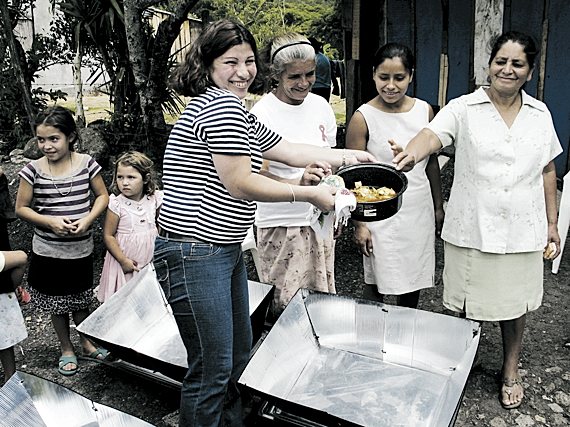
Bonnie Steele associates the word “charity” with a government food truck. Growing up in North Minneapolis, the truck would pull up, neighbors would crowd each other out to get free food, and Steele remembers feeling ashamed.
Her shame wasn’t in their poverty, she said, but in being somebody else’s goodwill project. In the context of Catholic sister parishes in Third World countries, Steele said it’s easy to focus on tasks instead of personal relationships.
Some partnerships between dioceses in other countries and the Archdiocese of St. Paul and Minneapolis are just beginning while others date back more than 20 years. All of them will refocus on strong relationship-building following an October conference put on by the Archdiocesan Parish Partnerships Team that formed in the spring.
After the keynote address by Steele, director of pastoral ministry for St. Joseph the Worker in Maple Grove, more than 50 men and women from a dozen parishes sat at round tables at Guardian Angels in Oakdale to talk about what a mutual sister-parish relationship looks like.
Human connections

St. Edward in Bloomington sent its first group to sister parish Nuestra Señora de los Ángeles (Our Lady of the Angels) in Jinotega, Nicaragua, in 1988, to express solidarity during the Iran-Contra conflict.
Most of St. Ed’s parishioners hear about their sister parish in the Sunday bulletin, at a yearly fundraiser or from the pulpit. Some, however, like Sue Kellett, have invested in the long-term relationships and frequent visits that sustain the partnership.
The trick, Kellett said, is to look at your brothers and sisters and see the eyes of Christ. Doing mission means making human connections instead of simply bringing aid or working on a project. Unlike Steele’s government food truck, Catholic mission in foreign countries should be rooted in loving friendship.
Kellett said she has as many friends in Nicaragua as she does in the U.S. They call her “Hurricane Sue” because her visits are such a whirlwind of activity and work. Kellett facilitates everything from building small chapels for “campesinos” (peasants) in remote areas to exterminating mice from a community food pantry. Receiving hospitality from the Nicaraguans is also part of the equation, though.
Jinotega has deep Catholic devotion that Kellett enjoys during her two- to three-week visits several times a year. Nearly every family has an altar with holy pictures, statues and candles placed prominently in their home, she said. Neighborhood groups enjoy snacks and fellowship after praying the rosary daily.
Parish partnerships like the one between St. Edward and Nuestra Señora de los Ángeles are the product of many years’ effort on both sides. Other churches are just discovering the richness of relationship.
Parishioners from Most Holy Trinity in St. Louis Park — soon to merge with Our Lady of Grace in Edina — transitioned away from the send-a-donation model that was standard since 1990. In 2006, the first-ever envoy of parishioners visited its sister parish, San Maximiliano Kolbe, in Comayagüela, Honduras.
“There was absolutely no relationship in the beginning,” said Steve Kraemer, a Most Holy Trinity parishioner who has since visited Honduras three times.
On a 2008 trip, Kraemer helped members of his sister parish dig a ditch around a chapel so they could reinforce it with concrete walls.
“Here we had a chance to be joking, smiling, drinking soda and sweating next to each other in the hot sun,” Kraemer said. “That was a way to build a relationship.”
In October 2010, Most Holy Trinity signed a covenant agreement with San Maximiliano Kolbe, pledging mutual desire to deepen their communion of faith.
A month ago, four Franciscan friars from San Maximiliano Kolbe visited Minnesota to offer Mass and visit. Before flying back, Pastor Isidoro Mejia went to Best Buy with local parishioners to purchase a laptop with a webcam so they could Skype.
Sharing ideas
The Parish Partnership Conference allowed people from churches around the archdiocese to share what has and hasn’t worked.
“Our American culture is sort of a can-do, fix-it, solve problems culture,” said Mike Haasl, global solidarity coordinator for the archdiocese’s Center for Mission. “But what happens is the people themselves can get left out of the conversation.”
In some of the towns where the archdiocese has sister parishes, NGOs are already working on infrastructure to provide for people’s basic needs, so service projects aren’t necessary, Haasl said. In other places where work projects are needed, missioners need to work with residents in the planning.
Working with, not for, sister parishes restores the people’s dignity and puts everybody on equal footing, Steele said in her keynote. It’s important that sister parishes in Haiti, Peru and all over the world know that they have gifts worth sharing with Minnesotans, she said.
“The parish partnerships aren’t fundamentally about resolving people’s issues, they’re fundamentally about being brothers and sisters with one another,” Haasl said.



